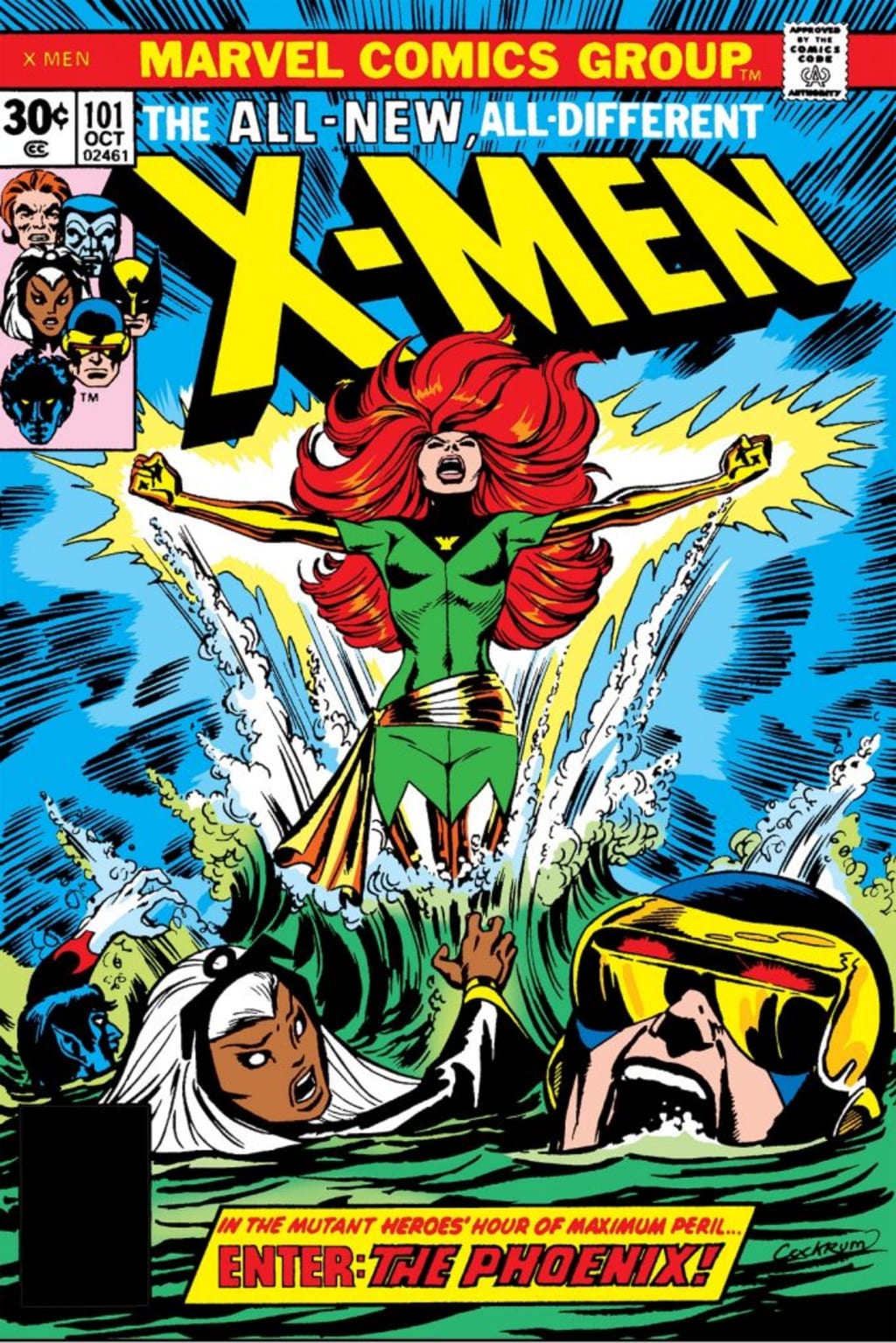
The 1970s began what is generally called The Bronze Age of Comics, with the Silver Age running from DC's "Showcase" #4 until about 1970, when comic prices increased and comic themes changed. They weren't just for kids anymore, they were written for college students and adults who had grown up with the characters in the comics, so the characters grew up, too.
1. The Death of Gwen Stacy (Amazing Spider-Man 121-122)

Nowhere is the changed attitude of the Bronze Age more evident than in this epic storyline, which has been touched upon in at least 2 of the Spider-Man movies to date, and which continues to be relevant in the comics to this day. While major characters in comics had been killed as long as there had been comics, they had typically come back time and again. And, similar to the old movie serials with damsels in distress, the hero always rescued the girl before the villain could kill or really harm her. This story changed all of that. In this, Gwen Stacy, the love of Peter (Spider-Man) Parker's life, dies of a broken neck not because the Green Goblin broke it, but because it accidentally broke when Spider-Man was saving her. In the battle afterward, the Green Goblin dies as well, or seems to. Original Goblin Norman Osborn returned decades later to become one of the biggest villains of the Marvel Universe, leading the Thunderbolts and his own team of Dark Avengers.
2. Introduction of Talia and Ra's al Ghul (Batman 232)

You may have noticed there were no DC stories mentioned in the first part of this series. That's because of the initial difference between how DC did things and Marvel did. DC had been the #1 publisher for decades, and one of the things Marvel did differently when the Marvel Age of Comics began in the 60s was to have stories that lasted more than one issue. Before then, comic stories always wrapped up in the same issue, and it was even common to have more than one story per comic. Publishers thought that the way to sell comics every month was to have exciting characters people want to see again. Marvel thought what would work even better is if there was an engaging story that you had to see continue or conclude.
Even in the 70s, it was uncommon for DC to have a story continue into another issue, but it did happen. What they did do was adjust the tone of their comics for an older audience, starting with Batman. Robin, forever known for nearly 30 years as the Boy Wonder, was now the Teen Wonder. And to get out of the shadow of the TV show starring Adam West as well as the cartoons, the Dynamic Duo was split up, starting with this issue. The reality of crimefighting is shown as Robin is shot and seriously injured. Batman decides it's too dangerous to keep Robin as a partner and he forges on alone. Eventually Robin recovers and carries on in a solo career and as leader of the Teen Titans, but for the most part afterward, Robin is out of the book.
Created by the legendary team of writer Denny O'Neil and artist Neal Adams, this storyline also marks the introduction of Ra's al Ghul, one of Batman's greatest enemies, and his daughter Talia, who would go on to be his second greatest love interest (after Catwoman).
3. Avengers/Defenders War (Avengers 116-118, Defenders 9 +10)
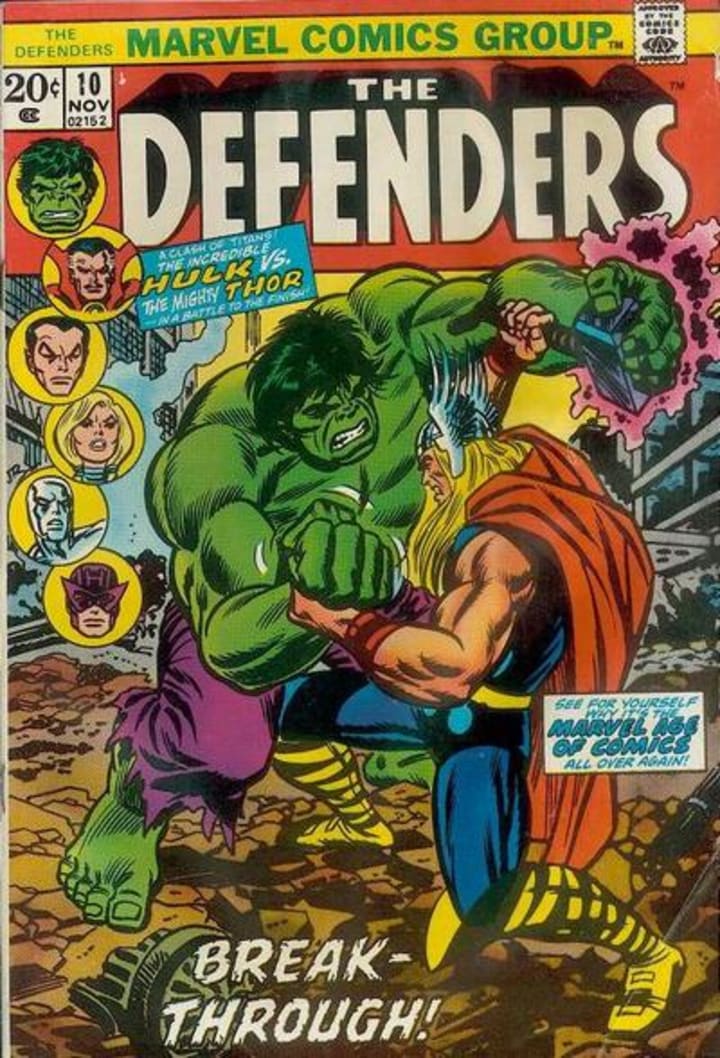
Prior to this, the Avengers had fought the original X-Men for an issue, and the Avengers had encountered the Fantastic Four, but the Defenders were a new team comprised of the most powerful characters in Marvel's roster, and this storyline pitted them against each other for not one issue, but several issues, including a classic Thor vs. Hulk fight that has yet to be equalled. Also noteworthy from this story is the appearance of Hawkeye as a Defender. He wasn't on the team long, but he was on the team.
3. Six-armed Spidey/intro to Morbius (Amazing Spider-Man 100-102)
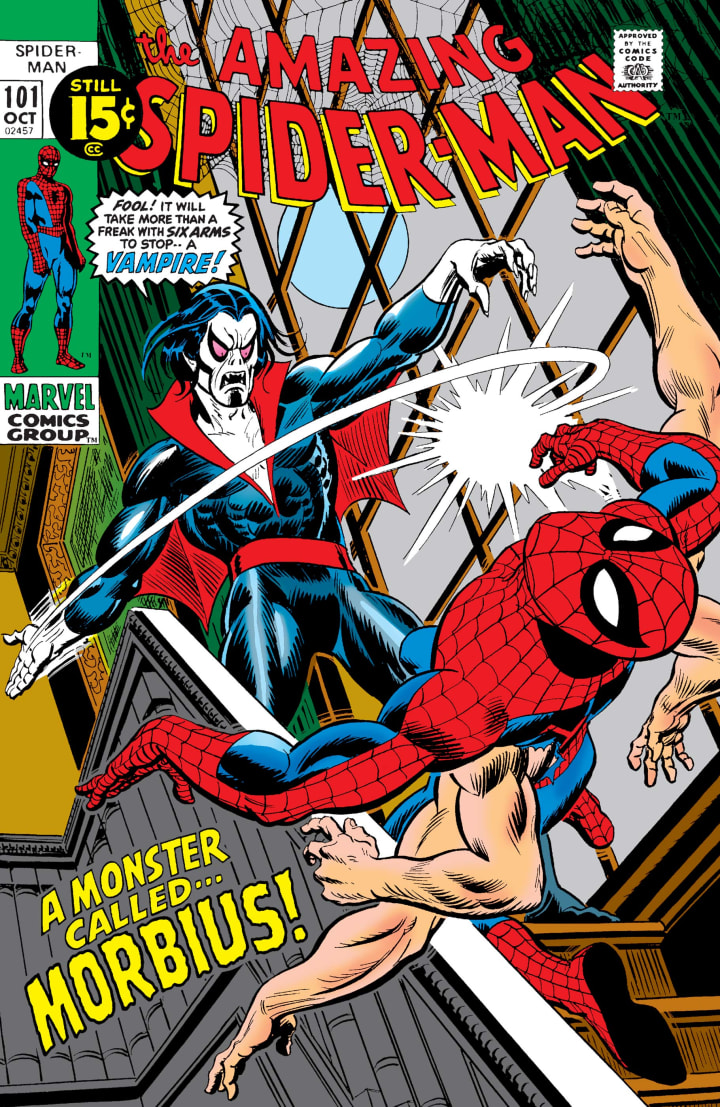
If you want to see where Jared Leto's Spider spin-off character Morbius got his start, it's here. If you also want to know why there was a Spidey action figure with 6 arms back in the 90s, it's because of this story. Tired of how much tragedy being Spider-Man has brought to his life, Peter Parker tries to rid himself of his spider-powers and fails. He still has his spider powers, and has become even more spider-like, sprouting 4 more arms that he has to learn to control. To get rid of them, he seeks out Dr. Curt Connors, aka the Lizard, who is an expert in limb development.
At the same time, Dr. Michael Morbius, a brilliant scientist with a rare blood disorder, also conducts an experiment on himself to try to rid himself of his problem. Like Spider-Man, he also fails, and ends up turning himself into a living vampire with enhanced strength and a thirst for blood, but without the supernatural weaknesses or abilities of an undead vampire, like destruction by sunlight or the ability to change form. When Spider-Man encounters the Lizard and Morbius together, it takes all 6 arms to hold them at bay.
4. The Clone Saga (Amazing Spider-Man 147-149)

This saga actually runs quite a bit longer, starting with the Death of Gwen Stacy, but the climax is in the issues above. After being a thorn in Spider-Man's side since Amazing Spider-Man 129, The Jackal is revealed to be Peter Parker's biology professor, who was infatuated with Gwen Stacy and blamed Spider-Man for her death. He creates clones of both Gwen and Peter Parker, learning in the process that Parker is Spider-Man. He then pits this Spider-clone against the real Spider-Man, creating a crisis of identity and additional problems for Parker the likes of which he had never seen before.
This storyline led to a sequel 2 decades later, the much longer, much more complex, and infamous storyline known as the Spider-Clone Saga. Infamous in that it went on and on and on and was just not as good, which largely describes comics in the 90s.
5. Jarella (Incredible Hulk 140)

Throughout the 60s and into the 70s, Hulk comics were typically about the Hulk trying to be left alone, but he was hounded by the Army, who wanted to contain or end the threat the Hulk represented. He rarely had any rest and had no lasting friendships aside from Rick Jones and sometimes Betty Ross, Bruce Banner's love interest. New stories were typically about Hulk stumbling into trouble as he went to different areas of the world to get away from being pursued, or his enemies using new methods and foes to try to destroy him. This storyline breaks that cycle by actually giving Hulk what he always wanted: Intelligence, people who appreciated him, and a woman who loved him.
Starting with a story written by sci-fi legend Harlan Ellison, and co-starring the Avengers, the Hulk is shrunk down to subatomic size, where he enters a subatomic world where sorcery and science are one. The people there have green skin like the Hulk, and they use their magic to finally give Hulk Banner's intelligence but Hulk's strength. He becomes the hero of their people and the consort of their princess, Jarella. For the first time since becoming the Hulk, life is good for Banner. Hulk ends up having to go back to our world, but the storyline continues off and on for several years, with Hulk returning to the micro-world, and even Jarella coming to our world, before it finally ended in issue 205. The story is one of the best, and most tragic, in the Hulk's canon.
6. Panther's Rage (Jungle Action 6-18)

If you liked the Black Panther movie, you have to read this story. While Stan Lee and Jack Kirby established the basis for the character the Black Panther and the land of Wakanda in the pages of Fantastic Four, the Panther legend really grew here, with the introduction of Kilmonger and the Panther's supporting cast. The Black Panther still didn't have a title of his own yet, at least not one called "Black Panther" but he did star in Jungle Action, and this was the first epic of several that showcased the greatness of the character, taking comics from beyond the level of entertainment and to the level of illustrated literature.
7. Warlock/Death of Warlock (Warlock 9-16, Avengers Annual 7, Marvel Two-in-One Annual 2)

Warlock started out as a character called Him, an artificial creation meant to be the perfect human, literally a golden child with gold skin and hair. He rebelled against his creators and left Earth, encountering the mega-scientist the High Evolutionary, who had established himself as a god figure over a world of his own creation, Counter Earth, which was a planet exactly like Earth, on the exact opposite side of the Sun. With each planet orbiting the Sun at the same time, with the Sun between them, the two planets would never be aware of each other and the High Evolutionary could work on his experiments with life forms and societies undisturbed.
Warlock became a messianic figure for the people of Counter Earth, and he struggled against the Ani-Men, in the pages of "Strange Tales" and the first 8 issues of his own series before the series was cancelled and Warlock seemingly died. But writer Jim Starlin, who was writing "Captain Marvel," wanted a new challenge, so he revived Warlock and gave him new companions, Pip the Troll and Gamora, the most dangerous woman in the galaxy (yes, later of Guardians of the Galaxy fame) as he continued his evolution to become a sort of galactic messiah.
If you're a fan of Thanos and the Infinity Gauntlet, the story truly begins here, as Thanos, who had already appeared in "Captain Marvel" and "Iron Man," becomes one of the great villains of the Marvel Universe, and the tale of Warlock, from start to epic finish, becomes one of the great, complex stories. Starlin writes and illustrates the series, providing art that has to be seen to be believed.
8. Project Pegasus Saga (Marvel Two-in-One 53-58)

In the 60s, "Fantastic Four" was Marvel's most popular comic, and the Thing was the most popular character in the comic. He and the Human Torch had their own series in Strange Tales for a time, and in the 70s the Thing was given a starring role in "Marvel Two-in-One", where each issues featured the Thing and either an established Marvel character or a new one Marvel was trying to introduce. Team-up books were not a new concept, but what made this one different was character development. The Thing was taken out of his established role in the FF and given a chance to shine on his own, facing legal issues, personal problems, and other challenges we had never seen before. Plus it showed the Thing as an integral part of the Marvel Universe as a whole, as he worked with characters from Daredevil to the Avengers.
In this story, the Thing accepts a job working at the top secret scientific facility Project Pegasus as their head of security. There, he encounters several figures who would play major roles in the Marvel Universe in the future, including future cosmic hero and Avenger Quasar and Deathlok. Project Pegasus itself is referred to again and again over the years as a place where super-secret, super-shady things occur.
9. The Serpent Crown Affair (Marvel Two-in-One 64-67, Marvel Team-Up Annual 5)
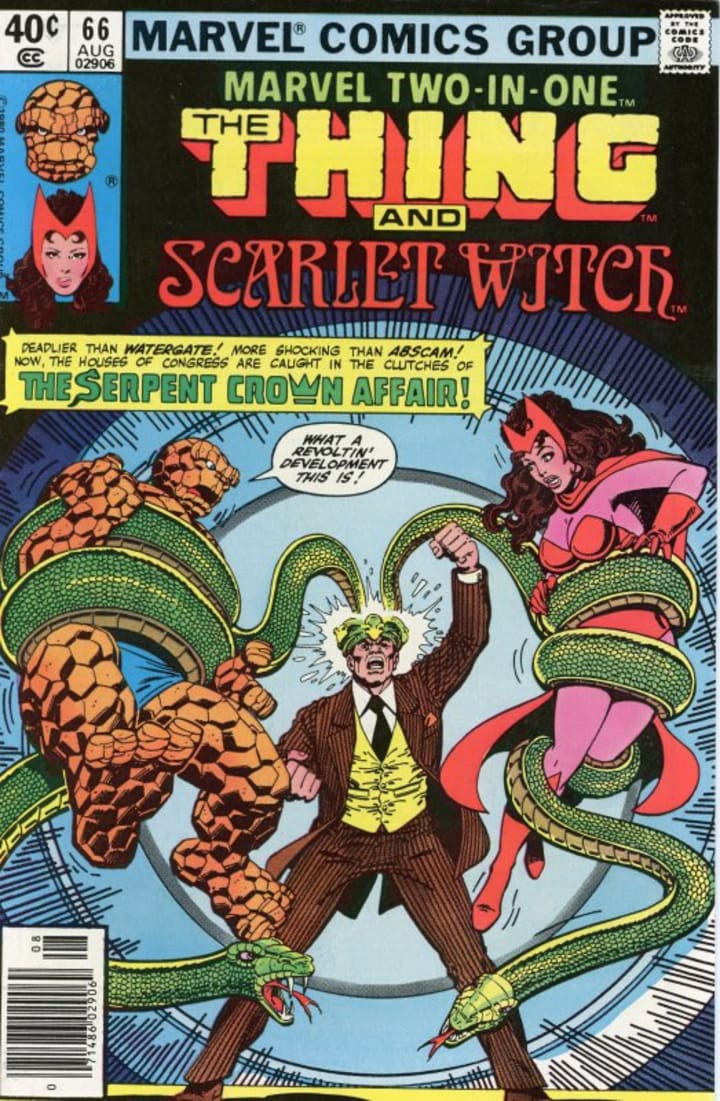
Essentially the Serpent Crown is an ancient artifact that grants the user great power. There are many crowns across many different realities, and the more of them you have the more power you control. Given that Marvel Two-in-One was at its peak in the years after Watergate, this story and others made good use of the theme of the quest for politicians and business leaders to achieve power by any means necessary. Thus elements as you see in the cover above.
This storyline was revisited in 1989, during the massive "Atlantis Attacks" crossover.
10. Eternals Volume 1

Jack Kirby co-created most of the characters in the Marvel Universe with writer Stan Lee before leaving for DC comics in 1970. There he created the New Gods and other charcters before returning to Marvel, where he wanted to continue to create new characters as both artist and writer. The Eternals were probably the best of these new creations, in which Kirby created a brand new mythology of alien characters who were the inspiration for legends around the world.
11. The Korvac Saga (Avengers 167-177)

12. Scarlet Witch at Wundagore (Avengers 186-187)

Quicksilver and the Scarlet Witch first appeared as villains, members of Magneto's Brotherhood of Evil Mutants in the pages of X-Men 4. They later reformed and joined the Avengers, but their origin was never revealed. Here, the twin mutants travel back to their homeland in Eastern Europe, where they meet the genetically engineered cow-woman Bova and learn of their ties to the High Evolutionary and two heroes from Marvel's Golden Age. At the same time the ancient wizard Modred the Mystic captures the Scarlet Witch and uses her as a vessel for the dark god Cthon. This story changed everything for the Avengers, Quicksilver, and the Scarlet Witch forever.
13. X-Men Second Genesis (Giant-Size X-Men 1, X-Men 94-95)

You've probably seen the cover above 100 times. It's been reproduced and imitated many times over. It's iconic. And as the reboot for the X-Men team, it's legendary. "X-Men" was never a hot title for Marvel, which is why the original book about teenaged mutants was cancelled. With Giant-Size X-Men 1, a new international team was formed to rescue the originals after they were captured by the sentient mutant island Krakoa. In X-Men 94, the first issue with new content in several years, the original team resigns (except for team leader Cyclops) and the new team of Storm, Banshee, Colossus, Wolverine, Nightcrawler, and Thunderbird must train before being sent on their first mission. This initial story concluds with issue 95, where for the first time, an X-Man is killed in action. Written by Len Wein and Chris Claremont with art by Dave Cockrum, this arc starts the greatest period in X-Men history.
14. The Phoenix Saga (Uncanny X-Men 99-138)

When original X-Man Marvel Girl (Jean Grey) sacrifices herself to protect the X-Men from radiation while coming back from a space station, she finds herself reborn in the hyper-powered new form of Phoenix. As Phoenix she rejoins the team, but finds herself changing mentally, even as her powers continue to grow. This change for the worse is quickened if not initiated by the secret manipulations of one of the X-Men's oldest foes, Mastermind.
This epic by Chris Claremont, Dave Cockrum, and John Byrne actually covers several storylines, all of them great, including:
- The new X-Men vs. Magneto
- The Proteus Saga
- The first appearance of Alpha Flight
- The first appearance of the Hellfire Club
- The first appearances of Dazzler and Kitty Pryde
- The X-Men's return to the Savage Land
15. Days of Future Past (Uncanny X-Men 141-142)

After the Phoenix Saga, Chris Claremont and John Byrne collaborated on one more legendary storyline before Byrne left, this tale in which the adult X-Man Kate Pryde, living in a dystopian future in which the Sentinels have taken over and most mutants are captured or dead unites her mind with the young teen Kitty Pryde in our present to try to prevent the nightmare future from occurring. Featuring the first appearance of Mystique's new Brotherhood of Evil Mutants, the story concludes the era of the greatest creative team in X-Men history.
16. Hard Traveling Heroes (Green Lantern/Green Arrow 76-89)

Writer Denny O'Neil and artist Neal Adams had already become a creative sensation working on "Batman" and "The Brave and the Bold." In 1970 they teamed up again, bringing new life to the "Green Lantern" title by adding Justice League member and popular "Brave and the Bold" co-star Green Arrow to the title.
Starting with the first issue, the series did something no other DC series had done before, making the stories socially relevant. Previous to this series, Green Arrow, who had never starred in a title of his own, was a Bruce Wayne knock-off character - a millionaire playboy who funded his crimefighting technology with his own fortune. But O'Neil and Adams took his fortune away and put Arrow in a rough neighborhood, where he and Green Lantern are approached by a local resident who asks Lantern when he'll stop using his power in space to help aliens and help people here on Earth. This enounter makes Lantern question everything about his mission, and the mission of the Guardians of the Universe (masters of the Green Lantern Corps) in general. Over the course of the series, Green Lantern, who is essentially a space-cop, and Green Arrow, who is in many ways an anti-authoritarian radical, team up to fight different types of evil and sometimes each other, as they would sometimes argue about what was right, but agree on what was wrong.
The series continued after the departure of Adams with new artist Mike Grell, who became a legend in his own right, but these issues were truly the stuff of legend.
17. The Son of Doctor Doom (Fantastic Four 198-200)
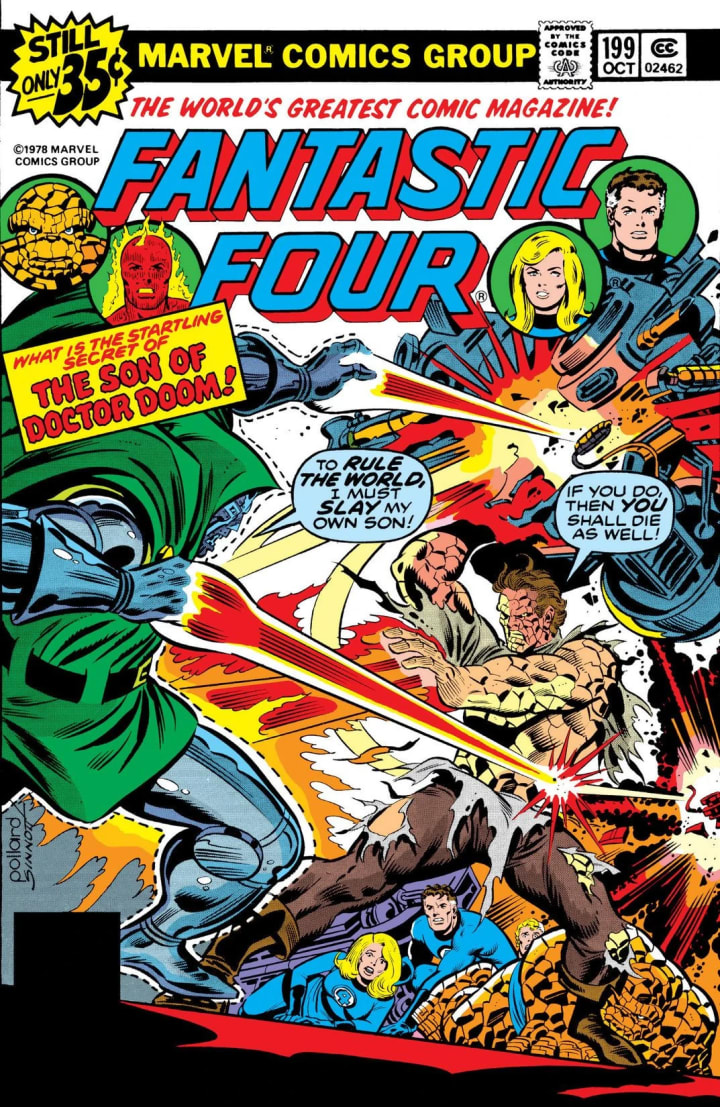
When you hear comics fans talk about Fantastic Four comics of the 70s they almost always single out this story as the greatest of them all. There were many great FF stories in the 60s, and some good ones in the 70s, but this one was the great one. Prior to this, the FF had been broken up for some time and the members had had various encounters on their own or in different combinations. In this story, the group comes together again as they face their greatest enemy, Doctor Doom, who has created a cloned version of himself as a son to rule his kingdom of Latveria as an heir. But prior to the son's coronation, Doom decides to give his son the gift of power by draining the FF's powers into him. The process is interrupted before it can be completed, and the son rebels against Doom, leading to the epic solo battle of Mr. Fantastic vs. Doctor Doom that shows Reed Richards is more than just a man who can stretch into bizarre contortions - he's m0re powerful than anyone had imagined.
18. Demon in a Bottle (Iron Man 120-128)
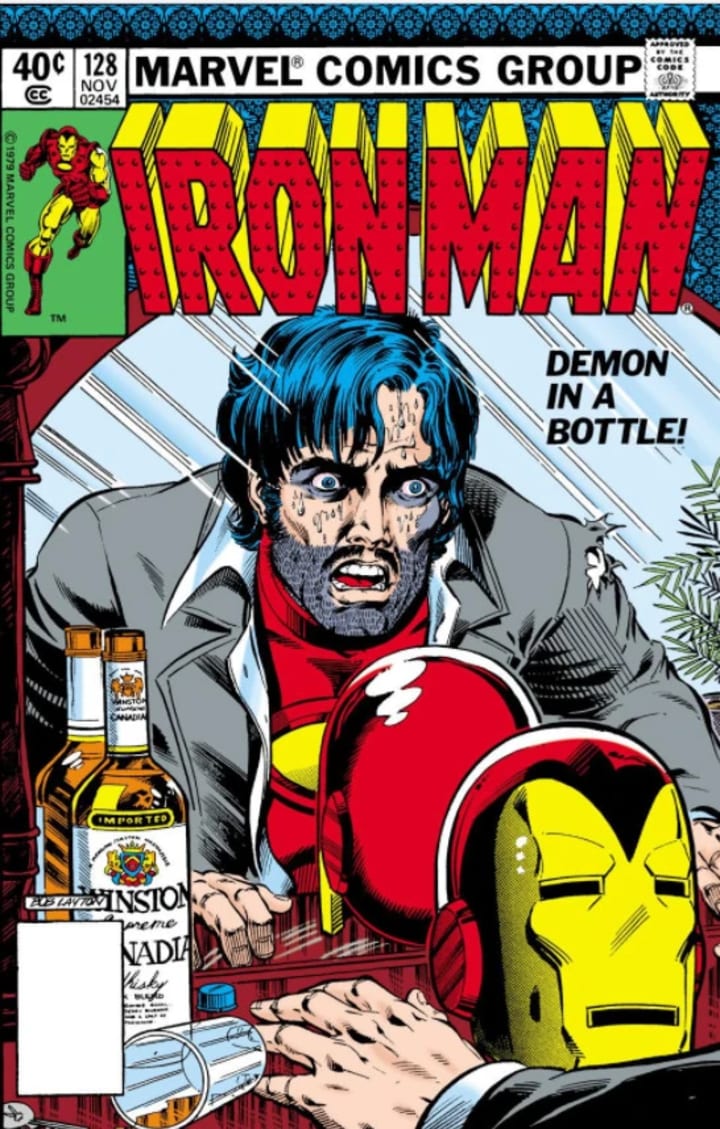
Written by David Michelie with art by definitive Iron Man artist Bob Layton, this storyline was the first and arguably best Iron Man epic ever told. Never completely explored in the MCU films, but alluded to in "Iron Man 2" and "Avengers," this story shows the downside of being Tony Stark (Iron Man) being a millionaire playboy, as his drinking goes too far, causing him to lose control of his business, his personal life, and his superhero career. Featuring a classic team-up with Namor the Sub-Mariner and tales of corporate espionage and intrigue as well as classic villains, this one needs to be read by every comic fan.
19. Avengers vs. Squadron Supreme (Avengers 141)

One of the great questions among comics fans has always been, "Who would win in a battle of the Avengers vs. the Justice League?" Answers would of course vary by who was writing the story and the lineup of each team. In the 70s, both teams aguably had their most powerful and popular lineups ever, but the two companies couldn't iron out a deal for a crossover the likes of the "Superman and the Amazing Spider-Man" special, though they did try. So, the Avengers were pitted against "The Squadron Sinister," villains who had identies and powers very similar to those of the Justice League. Even their origins were similar, with the chief example being the super-powerful Hyperion, the sole survivor of a doomed alien world. In this issue, we meet the Squadron Supreme, heroic versions of the Squadron Sinister who come from an alternate reality, making them even more like the Justice League.
About the Creator
Gene Lass
Gene Lass is a professional writer, writing and editing numerous books of non-fiction, poetry, and fiction. Several have been Top 100 Amazon Best Sellers. His short story, “Fence Sitter” was nominated for Best of the Net 2020.






Comments
There are no comments for this story
Be the first to respond and start the conversation.